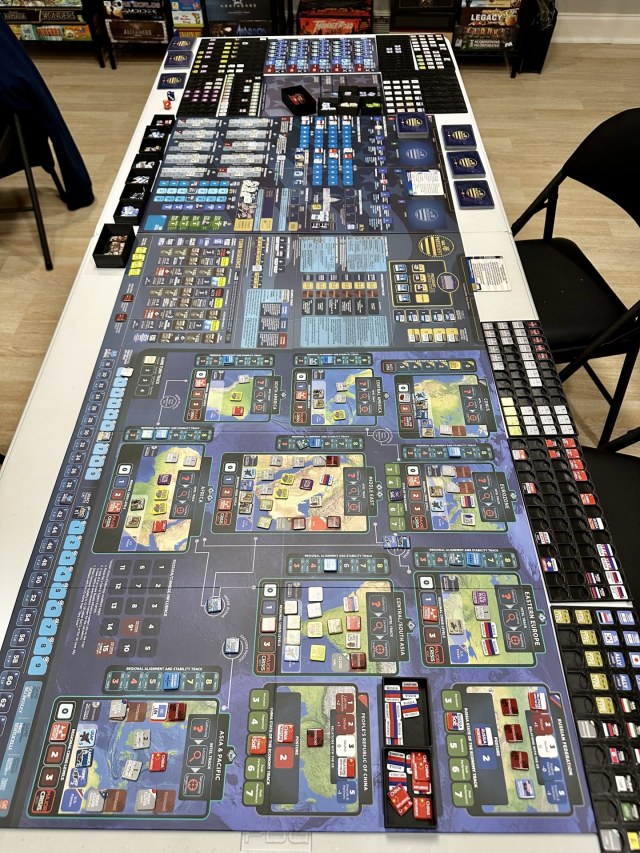
This is not a review of GMT’s Mr. President: . In order to write a thoughtful review, I usually figure that I need to have played a game 3+ times for a “heavier” game and 5+ times for something lighter. So far, I’ve managed one play of the basic (“sandbox”) scenario set to easy mode… and that took 5+ hours.
So, instead, this is a first impression of the table-eating design by Gene Billingsley – albeit one informed by a lifetime of gaming and a particular (some would say peculiar) interest in solo board games. And, in honor of Helen Thomas (long-time White House press corps member), I’m writing this in the form of a press conference.
Wait a minute – you said your first game took five hours?!
Yes. Yes, I did.
Five hours?!
I’m not going to make you feel any better by letting you know that I managed to eke out an automatic win at the end of year two of my presidency – meaning I didn’t actually play a full game. (And there’s an option to run for a second term… but we won’t even go there.)
On the other hand, the first year learning how the game worked took roughly 3.5 hours, with the second year only taking about 90 minutes. So there is a definite learning curve that eases up as you keep playing.
Get out of here as fast as you can.
Murray Blum, CPA in DAVE
How long does this massive game take to set up?
While I didn’t use a timer while I was setting up, I think it was probably 30-45 minutes – granted, this was my first time playing and getting a game under my belt will make it much quicker to set up next time. (Also see my answer about 3D printed trays below.)
Somebody said there were a lot of rulebooks… what say you?
Technically, there are only three rulebooks – a small How To Play overview, a larger Governing Manual (aka “main rulebook”) and a folio of Scenarios.
That, however, doesn’t include the multiple books of charts: World, Domestic, Allies & Rogue States, China, and Russia. Nor does it include the incredibly helpful Turn Order flipbook, a spiral-bound book that walks you through each part of a turn step-by-step.
There are also four double-sided player aids – one each for Presidential, Domestic, Diplomatic, and Military actions.
And, for good measure, there is a separate book of designer notes with some help for your first game.
That’s a lot of rulebooks.
True… but I’m an old-school wargamer who also DM’d D&D and Traveller campaigns in the pre-computer days (aka “the early 1980s”) so this wasn’t overwhelming. I’m used to CRT (Combat Results Table) lookups and diving through multiple manuals to find a single elusive chart.
Credit where credit is due: the team of folks from GMT did a really nice job of compiling the rules and charts in a format that makes it easy to find what you’re looking for. I didn’t have any real issues with finding what I needed. (Note: there is a FAQ with errata available on the GMT site.)
Caveat where caveat is due: GMT has already announced an update kit for Mr. President (as well as a 2nd edition printing of the complete game) to incorporate errata and clearer wording from the FAQ for the 2nd Edition, as well as numerous game enhancements to make the game more challenging (especially in years 3 and following) and to add features, importance, and more difficult choices to areas of the game. (And, yes, I’ve already ordered it.)
Did you really need the 3D printed trays?
The game is playable without a specific storage solution – but it’s substantially easier to set up and play if you find some way to organize the 500+ counters/chits. The old school wargame chit organizers could work for this… or, you could splurge a bit and get a 3D-printed system.
I’m happy to recommend the Mr. President storage solution from PrintablesByCaren – it comes in both a printed version or you can simply order the STL files from her and print the pieces yourself.
After my first play, I reorganized the single bit trays to make it easier to divide them up in ways that aligned with how I set-up and play the game – which should make it even easier. (Photos of my tray layout are at the end of this post.)
The picture at the top of this “first impressions” post looks like it takes the entire table to lay out the game – is that really the case?
Mr. President is a table eater of the first order – though the 3D printed trays do take up a decent amount of space as well.
What you can’t see in that picture is that I’m using a chair for the stack of player aids/folios with charts.
Optimally, you would like to have a large table plus a small side table (for rules/charts) where you can leave the game out over a decent amount of time. (I’m privileged to have a space where I can do just that.)
Hail to the chief / He’s the one we all say “Hail” to. / We all say “Hail” / ‘Cause he keeps himself so clean! / He’s got the power, / That’s why he’s in the shower…
“Bill Mitchell” from DAVE
OK, we’ve asked enough questions about the logistics of the game – tell us more about the game itself.
I’ve already noted that my gaming background includes a lot of AH and SPI wargames as well as game-mastering role-playing games – specifically Advanced Dungeons & Dragons, the early editions of Traveller, and (more recently) Savage Worlds. Mr. President has strong elements of both of those worlds, including combat based on strength ratios (classic wargame stuff) and numerous “skill checks” (RPG stuff) across a wide variety of game situations. Not to mention a serious amount of DRMs (Dice Roll Modifiers).
I actually told my wife that Mr. President was basically a RPG for people interested in domestic and international politics – and I stand by that statement. (I’m Mark Jackson, and I approve this message.)
The game is more tactical than strategic – you’re often responding to whatever stupid thing just happened – a cyber attack by Russia, scandals in your cabinet, keeping Congress happy, the fickle mood of the American people, etc. – and your long-term plans can easily go up in smoke. Those “stupid things” are generated by the myriad of charts – and an event deck that can be generate both one time events and cascading events… in other words, events that can come back to haunt you at later times during the game.
Along with that, you’re telling a story – much like a RPG, you’re the lead character in a complicated drama that you can influence but not control. And, much like both RPGs and wargames, some dice rolls will break your way in stunning ways, while others will doom you into a spiral of bad consequences.
For example, while I couldn’t keep the Middle East from being a hotbed of rogue nations and civil wars, I managed to eliminate Chinese influence in the Asian Pacific and even slow down North Korea’s move towards nuclear weapons. At home, we managed to pass landmark legislation, even as the public kept changing their minds – and at the same time kept our economy incredibly strong. The seemingly constant hassling with Russian (cyber attacks, supporting Serbia attacking the Balkan States, etc.) didn’t overwhelm me – but I can easily see where multiple small wars could metastasize in a whirlwind of bad outcomes.
What’s Next?
President Bartlet – THE WEST WING
It sounds like there are a lot of choices to be made – isn’t it overwhelming?
Thanks to the game design, you are only making a small number of decisions at any one time. While you need to keep your eye on possible ramifications of your decisions (Am I leaving myself enough action points in case something else goes wrong? Will this decision affect one of my allies? Do I have the ability to assuage their frustration with a later move?), the scope of decisions is – most of the time – limited by the game track (and the flip book, which walks you through the game track).
Due to the way the game tracks where you are in a turn, it was easy for me to play for 10-20 minutes and then get up & take care of other things. My five hour playing time was actually spread out over about three days.
Robin McCall: I think the important thing is not to make it look like we’re panicking.
President Andrew Shepherd: See, and I think the important thing is actually not to BE panicking.
THE AMERICAN PRESIDENT
Wouldn’t it be easier/better if this was a computer game rather than a table-eating monster board game?
Yes… and no.
Yes, for those who don’t have the space to set up the game and/or the ability to leave it out in the open for extended periods of time, that makes perfect sense. In fact, one of the reasons for the second edition update kit is to act as playable kit for charts/etc.for players who want to use Tabletop Simulator or Vassal to play the game.
On the other hand, no. The job of the President is an immense task – and the size of the board(s) play a role in giving the player the correct “feel” of that weight. By the same token, I find it much easier to play large games in-person… it’s easier to scan the table for information than it is to try & figure out where the developers have hidden a view or menu.
I also think that auto-calculating DRMs would “hide” some of the key elements of the game – how do I balance everything I need/want to do while saving enough action points in reserve for the inevitable unforeseen crisis?
Should every self-respecting board gamer own a copy of this game?
Absolutely not.
Well, maybe I can be a bit more nuanced than that and list the reasons I don’t think this is going to be for every gamer.
- Space needed to play
- Length of the game
- Solo player only (yes, you could work with a partner – but it’s designed as a single player game)
- Requires some basic knowledge of domestic U.S. and international politics
- It really is more of a RPG than a wargame… and not everyone wants a long game that is more about participating in a story versus controlling every detail of a system
If you were going to recommend one history book to read for background to the game, what would it be?
That’s easy – John Dickerson’s The Hardest Job in the World: The American Presidency does a tremendous job of showing the enormity of the role, the ridiculous expectations we’ve layered onto the job, and the completely inadequate system we have for picking the best-qualified person to be president of the United States. Plus, John Dickerson’s a very good writer with a sly sense of humor.
“Nothing comes to my desk that is perfectly solvable,” President Obama explained to the author Michael Lewis. “Otherwise, someone else would have solved it. So you wind up dealing with probabilities. … You can’t be paralyzed by the fact that it might not work out.” Thomas Jefferson explained this to his secretary of the treasury: “What is good in this case cannot be effected. We have, therefore, only to find out what will be least bad.”
John Dickerson, THE HARDEST JOB IN THE WORLD
Any last words?
Two things:
- Although I’ve only played once, I’m very glad I have this in my collection. I have plans to play again soon – I’m trying to decide whether to crank up the difficulty level or try one of the historical scenarios. Even pulling out the trays/books to take pictures for this make me want to set it up right now.
- GMT is currently taking orders for the 2nd edition of Mr. President using their P500 system… the P500 prices is $69 while the MSRP will be $110, so if you’re interested, it’s worth taking a look.
A note of a tiny yet possible conflict of interest: While I purchased my own copy of Mr. President and of the excellent 3D printed bit trays from PrintablesbyCaren, the developer of the game (Mike Bertucelli) was a long-time member of the gaming group I ran in Central California and a great guy to game with. (Mike is personally responsible for my older son’s very large X-Wing game collection – thanks to teaching him the game back when it was released.)
“I forgot that I was hired to do a job for you and that it was just a temp job at that. I forgot that I had two hundred and fifty million people who were paying me to make their lives a little better and I didn’t live up to my part of the bargain.”
“Bill Mitchell” from DAVE
Thoughts From Other Opinionated Gamers
Matthew M. (1 play – I like it) – If you’re looking for a game where you can identify and make the right choice and are always rewarded for doing so then Mr. President will fall flat. While your decisions contribute meaningfully to the story that unfolds, you are always somewhat at the mercy of fate via the dice. That degree of uncertainty is part of the simulation of being the leader of the US, but it’s also a big ask for a player when a game is as demanding of your time and space as this one. If you are willing to accept what the game offers on those terms then Mr. President offers an immersive solo RPGesque experience unlike many others. Its audaciousness and ability to generate memorable narrative moments earns it a space on my shelf, even if I’ll only find time to actually play it once a year.
And now, as promised, my layout for the bit trays…
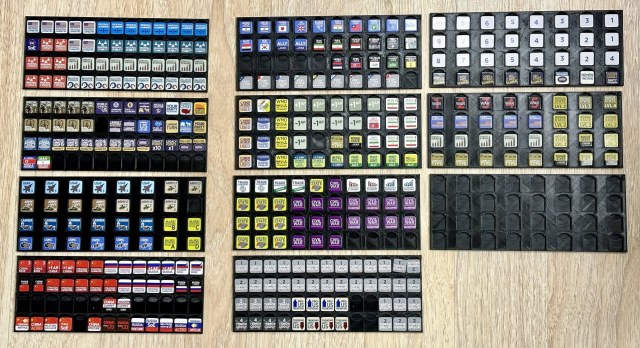
The four trays on the left are all or mostly initial setup trays… the seven trays on the right are elements that come into play during the game. (The empty tray was created by condensing some things and moving one set of chits to the boxes.)
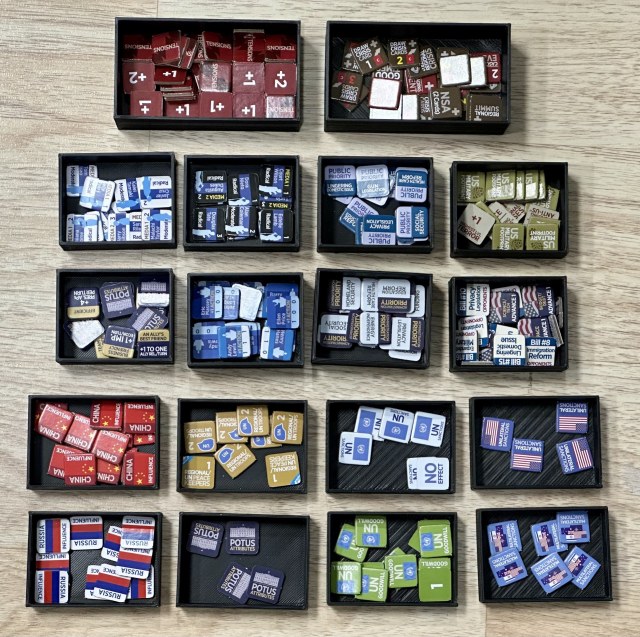
The boxes are in three sizes: large (top row), medium (middle two rows), and short (bottom two rows). I moved UN peacekeepers into an empty box which left me with one empty tray (see above).

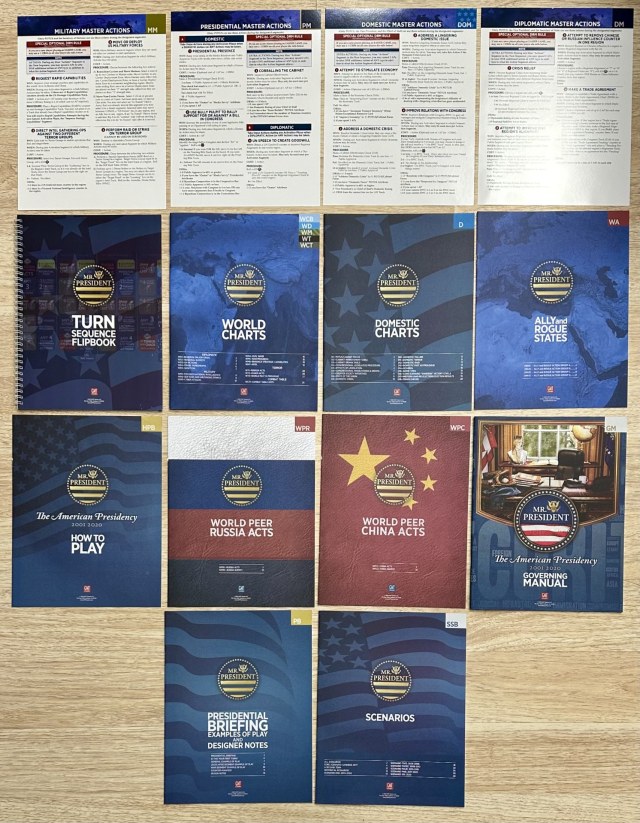
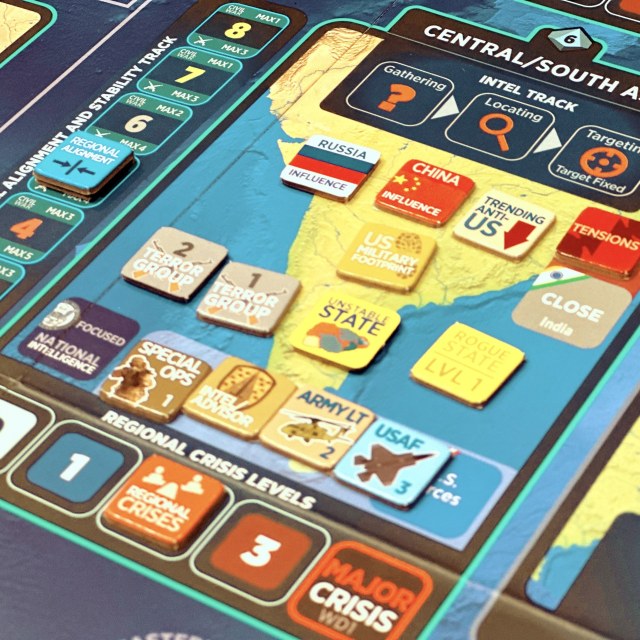
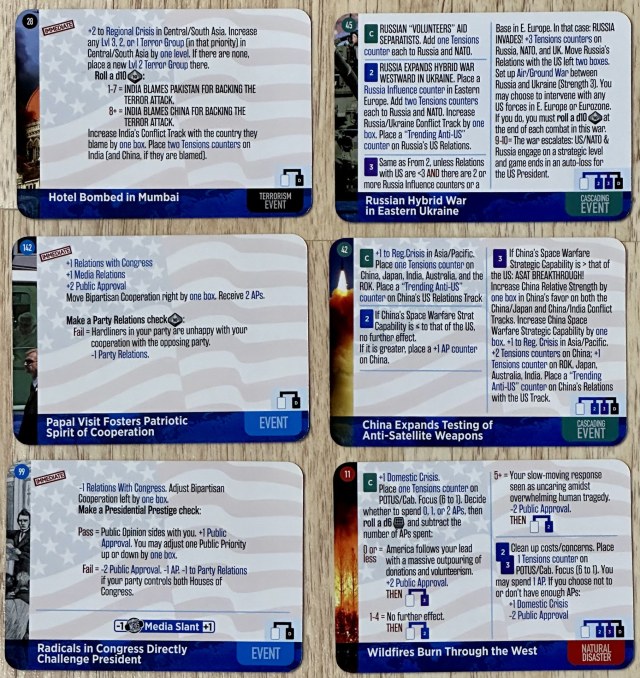
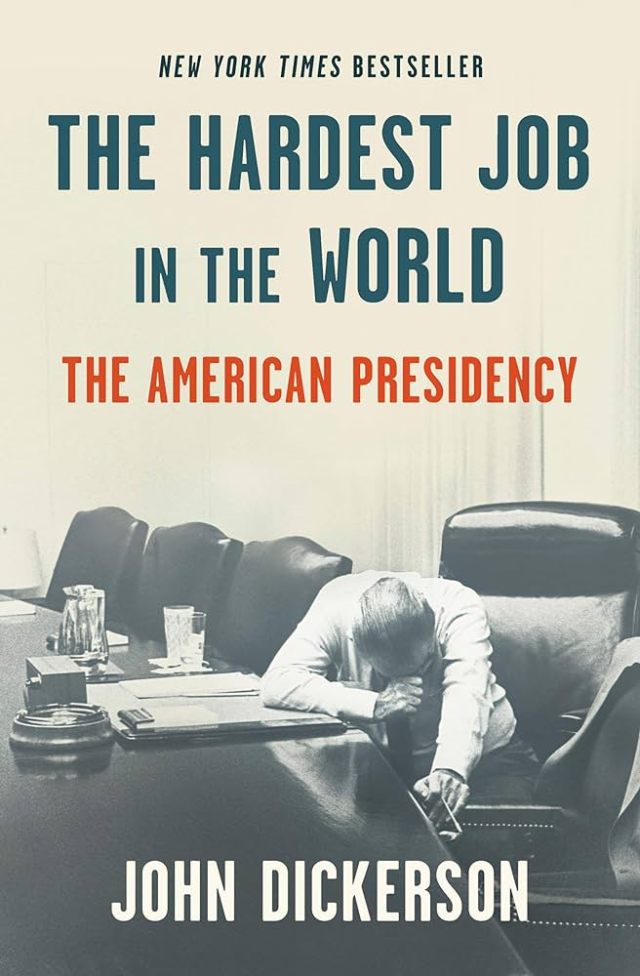
Ah, Mr. President. AKA “The Game That Tried To Kill Me”
Background: In August I developed a pulmonary embolism (blood clots) that eventually reached my lungs. My first “attack” from this came during a setup of Mr. President. I got light-headed and dizzy and needed to sit down. Unfortunately, a huge stack of books and boxes was on my chair. The only place to move them was on the table WHERE MR. PRESIDENT WAS SET UP. Stacking them on the table would have meant disrupting the 45 minutes of setup time I had already put it. I had to stumble across the room to the bed.
A hospital visit followed not long thereafter. Mr. President has since been traded away (for a long-coveted copy of Cloudspire). I mean, how could I look a game in the face again that tried to kill me?
First, I’m glad it was unsuccessful.
Second, I totally get trading it away.
Miss you, my friend – be well and enjoy Cloudspire.
Holy crap, Snoop! I hope you’re feeling better. I mean, I’ve heard of the Killer Joke, but not the Killer Game!
Most excellent write up, and very helpful for someone who has this game but has not played or set it up yet. I can see your comparison to an RPG — though its tactical nature was not one I assumed; I agree that those of us who played games from the early 80’s won’t be much bothered by the overhead. The trays from PrintablesbyCaren are worth the price in my opinion; thank you for including the pics of your layout.
Cheers!
Thanks, James… while you are setting yourself to pass certain bills and/or tamp down areas of conflict & unrest, you are always one bad crisis chit pull away from a cascade of stuff that interrupts you from following through.
Hope you enjoy it once it finally hits the table!
Can I ask how you decided what to put in which tray – was there an orginal optimal arrangement?
Thanks
John
Caren had pictures up on her site which I followed – but she clearly states “Included is 11 of these trays of different configurations so you can organize your chits EXACTLY how you see fit for the way you want to play.”
So, I worked to try & put chits together that either (a) were involved in inital setup, or (b) were used in similar activities during the game – terrorism, war, economics, etc. I also chose to put Russia/China on a single tray.